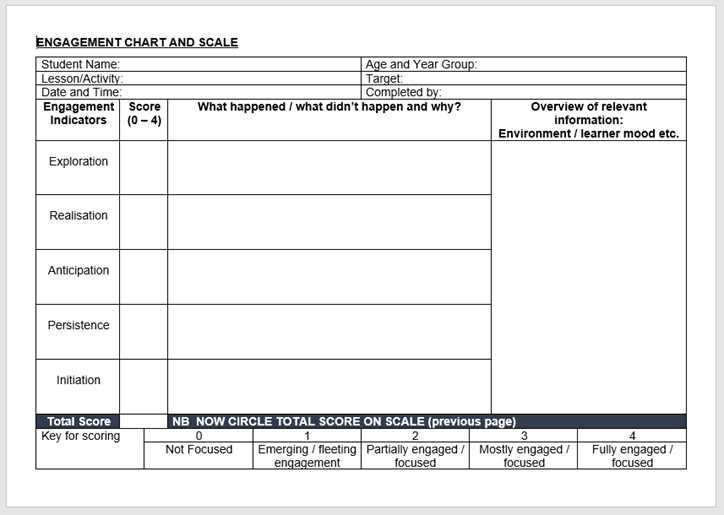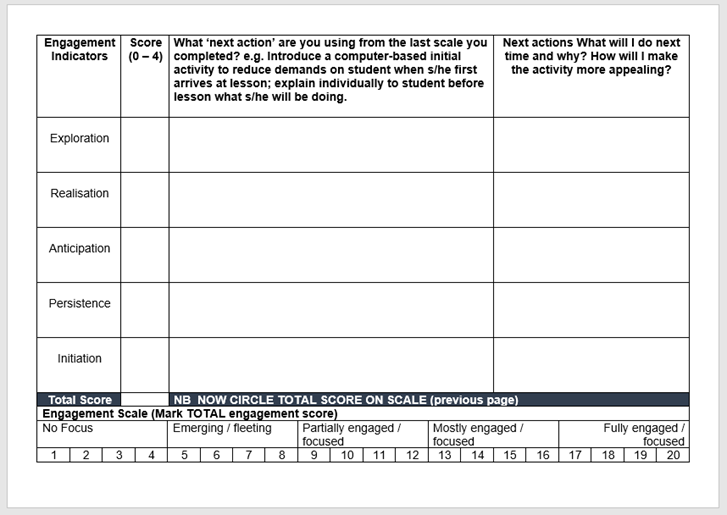Engagement Model Guidance
The Engagement Model at Reynalds Cross
Who is the engagement model for?
- It is statutory for pupils working below the Pre Key Stage Standards at KS1 and KS2.
- Schools have to report which primary-aged pupils are being assessed using the engagement model.
- As it is a valuable way of recording what our pupils are learning it is also being used for some of our older pupils at Reynalds Cross.
- The engagement model is mainly for pupils based in PMLD classes but also needs to be accessed by those pupils with more complex needs based in other classes.
What is the engagement model?
- It is an assessment tool used to measure both linear and lateral progress (and also in some cases the slowing of pupil performance).
- It is for pupils who are unable to demonstrate recognisable and specific skills, knowledge and understanding in English and mathematics.
- It does not replace our current curriculum which can be easily differentiated to meet the needs of all pupils while also allowing for them to be sufficiently motivated and stretched by the introduction of a range of topics and activities.
- It does not replace our current assessment and reporting systems but adds value to what we are already doing.
What are the benefits of using the engagement model?
- It uses a pupil-centred approach that focuses on abilities rather than disabilities.
- It supports with showing progress against the agreed outcomes in EHCPs.
- It promotes consistency and is a common language amongst those working with the pupil (including across schools).
How do we identify pupils who need to access the engagement model?
- Pupils assessed using the engagement model are described as having severe or profound and multiple learning difficulties meaning they have serious cognitive impairments and learning difficulties,
- Pupils working at development walls below PS4 will be considered for engagement model.
- Each year in the Summer term a list of pupils who fit into the engagement model will be identified in preparation for the new academic year. This will be done by the PMLD curriculum development group lead (with the support of the assessment lead) who will use SOLAR to identify pupils across school who have not yet fully completed PS3ii of the ‘sensory cross curricular PS1(i) to PS3(ii) bridging’ development wall.
- In the initial year (2022/23) all pupils across school were baselined against PS3ii and the information gathered from this was used to determine who needed engagement model assessments. In subsequent years any new pupils will be baselined and existing pupils levels checked to see if there are any changes which mean they now meet the criteria (progression or regression).
- Identification of pupils in EYFS/14-19 who meet the engagement model criteria are just for our purposes. These pupils do not need to have engagement model assessments completed. Information about EYFS pupils will inform us of any pupils coming through school who may need these assessments in the future. 14-19 pupils do not need engagement model assessments as progress is already carefully tracked through completion of ASDAN modules designed for pupils with more complex needs.
- Once pupils have been identified, training will then be given to any staff working with them.
How do we assess pupils using the engagement model?
- The model recognises that engagement is multi-dimensional and breaks it down into 5 areas: exploration, realisation, anticipation, persistence and initiation.
- These areas are not hierarchical, so there is no expectation that pupils need to demonstrate progress in all 5 areas.
- Progress through each of these areas is measured by identifying how established the pupil is against each of the areas of engagement.
- Assessment is completed during regular observation assessment by someone who knows the pupil well and has an understanding of child development.
- It is initially used to identify the pupil’s engagement during their highest-interest activity to create a baseline. This allows the teacher to reflect upon, trial and implement different ways to increase the pupil’s engagement in their education and development.
- Ongoing assessment then take place towards the start and end of every term, this enables a continuous cycle of ‘assess, plan, do and review’ to take place, which enables the pupils’ achievements and progress to be measured over time.
- Assessments should take no longer than 30 minutes recorded on the following sheets.


- Additional, simplified, optional recording sheets are also available to do further monitoring throughout the term. This includes recording sheets to use with SOLAR (our assessment tool) and tick sheets to record engagement in a range of activities.
- In order to ensure that everyone is making similar judgements, samples of work from pupils using the engagement model should be moderated by the PMLD curriculum development group on an annual basis. Where possible, external moderation of work will also take place.
- At the end of Key Stage 1 and at the end of Key Stage 2 teachers will be asked to assess pupils against the Pre Key Stage Standards to determine if they have reached the Standards or will need to continue to be assessed using the engagement model.
How does the engagement model fit in with existing assessment and recording systems?
- Where possible, assessment should be used to demonstrate progress towards targets already identified on EHCP/PLP.
- When target setting the 5 areas will be taken into account to support with showing the small steps of progress pupils working on the engagement model will make (i.e. language from the 5 areas should be incorporated in the targets to ensure they are SMART).
How do we keep parents informed of progress using engagement model?
- The PMLD curriculum development group lead will send out information at the beginning of each year to parents to advise them that the engagement model will be used with their child and what that means.
- Additional updates will be provided as appropriate through the curriculum newsletters, personal learning plans, EHCP reviews, transition passports and annual reports.
Where can I find any useful documents?
- More information about the engagement model can be found here - https://www.gov.uk/government/publications/the-engagement-model
- More information about Reynalds Cross approach to the engagement model can be found in W:\Curriculum and planning\Curriculum development groups\PMLD\Engagement guidance and assessment documents.
Where should I save my assessments?
- Completed assessment should be saved in the pupils individual file on the work drive under the heading ‘engagement model’. The file name should be the date the assessment was completed.

